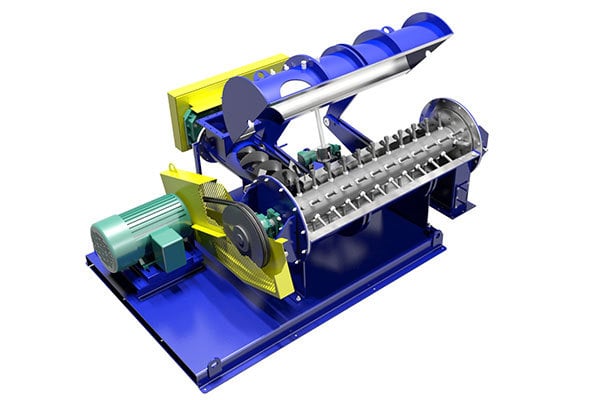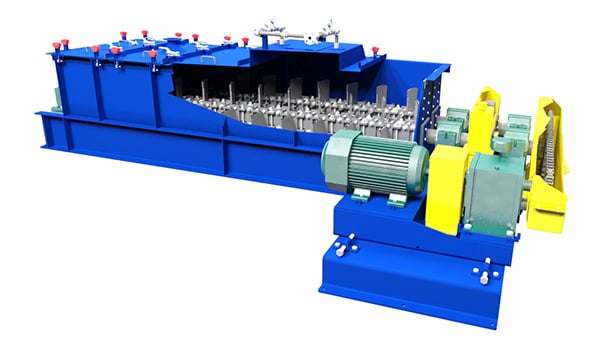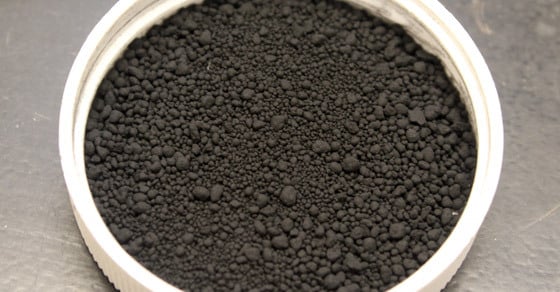Dust collectors serve a critical need in the industrial process setting, helping processors to keep workers safe, comply with regulatory requirements, ensure product integrity, and promote equipment longevity. And while baghouses, electrostatic precipitators, and other dust collection systems provide these benefits, processors are often left wondering what to do with the dust they collect.
The struggle with these materials, which can be significant in quantity, is that they pose an inherent challenge: as fine particulates, they are incredibly dusty and difficult to work with. To make the fines more manageable, whether for reuse, disposal, or otherwise, producers frequently employ industrial mixers to pelletize (agglomerate) the material.
Commonly Pelletized Dusts
Pelletizing is a broad term that is used to describe a range of agglomeration or particle size enlargement techniques. In this case, pelletizing refers to the upgrading of fines into small granules and may also be referred to as conditioning. Depending on the mixer chosen and the desired level of agglomeration, materials may also simply be wetted and roughly agglomerated. In some cases, a disc pelletizer may be added to the process after the mixer to create larger, more spherical pellets.
The widespread and diverse use of dust collectors means that the material collected can be anything from ore dust to fly ash. Materials that are commonly collected from dust collectors and later pelletized include:
- EAF Dust
- Alumina
- Cement Kiln Dust (CKD)
- Coal and Coke
- Fly Ash
- Ferroalloy Dust
- Glass Furnace Dust
- Lead Oxide
- Ore Dust
- Smelter Flue Dust
How Pelletizing Helps in Dust Management
The fine particle size of the particulates from dust collectors makes handling, moving, and feeding them difficult, as well as a potential safety hazard or liability. Through processing in a mixer, these fines can be wetted and agglomerated into dust-free granules, improving disposal characteristics, and in many cases, opening up a host of added-value opportunities.
Improved Disposal
When particulate dust is destined for landfill, pelletizing offers improved disposal by reducing or entirely avoiding the associated environmental risks. Handling, transportation, and landfilling becomes much easier and safer; fugitive dust is mitigated, avoiding windblown material and potential contamination to surrounding areas.
Realizing the Value of Particulate Fines
Historically, particulate matter collected in baghouses, electrostatic precipitators, and other dust collection systems has been disposed of. But as the shift toward sustainable resource utilization intensifies, processors are increasingly looking to maximize material usage and recover the value tied up in these fines. As a powder, they offer little to no value, but if pelletized, can be more readily reintroduced to the process, or prepared for beneficial reuse applications. The reuse of such materials has the potential to:
Mitigate Disposal Costs
When employed in a beneficial reuse application, treatment of dust collector fines can eliminate disposal costs that would otherwise be incurred.
Conserve Natural Resources
The world’s growing population is demanding more material resources than ever before, prompting worries over exhaustion of naturally occurring resources critical to everything from food to defense. Recovering and reusing these raw materials is essential to maximizing the resources available to us.
Create a New Source of Revenue
Often, valuable components may exist in the dust that could be recovered and repurposed, creating a new product and an additional source of revenue.
Improve Process Efficiency
When valuable materials can be recovered and reintroduced back into the process, the process becomes more efficient.
Additionally, when pelletized, downstream processing may also be improved. Smelter flue dust, for example, is often valuable and must be recovered. But if put directly back into the smelter, the dust would simply become entrained in the air flow and carried out to the dust collector again. By pelletizing, these materials can be put back into the process without the risk of entrainment.
Pin Mixers and Pugmill Mixers for Pelletizing Fines
Industrial mixers are employed throughout nearly every industry to accomplish a wide range of goals, ranging from preconditioning material, to dust suppression, and even creating end products. Pin mixers and pugmill mixers are the preferred mixers in these efforts, as a result of their ability to de-dust material fines and produce small agglomerates.
How Pelletizing in a Mixer Works
The use of a mixer to pelletize material fines is a form of agitation or tumble growth (non-pressure) agglomeration.
As such, the act of pelletizing relies on motion and a liquid binder to collect fines into small masses that are then densified and rounded into cohesive granules. Fines are fed into one end of the mixer, while a liquid spray system distributes binder across the material bed. The binder and fines are processed into a homogeneous mixture that then begins to agglomerate as it moves down the length of the mixer. As the material agglomerates, it is continually densifying.
Both types of mixer offer continuous processing capabilities with the opportunity for multiple liquid and solid feed components. The choice between the two mixers depends on the material.
Pin Mixers
Originally developed for processing carbon black, the pin mixer is engineered to provide optimal dust dewetting and agglomeration (often referred to as micropelletizing). The intense rotational spinning action imparted by the single shaft rotor affixed with pins thoroughly combines liquid and solid feed into a homogeneous, densified product.

3D Model of a FEECO Pin Mixer used for pelletizing baghouse fines and other dust collector particulates
Pugmill Mixers
While the pin mixer provides an ideal processing environment in most cases, its intense spinning action is not a fit for all materials.
For materials that are more abrasive, where tramp material may be an issue, or when more heavy-duty processing is required, the pugmill mixer offers a more effective option. Pugmill mixers use twin counter-rotating shafts fitted with paddles to impart a kneading, folding over motion backed by a high torque.

3D Model of a FEECO Pugmill Mixer used for pelletizing baghouse fines and other dust collector particulates
The choice between the two mixers may not always be clear. When such a decision arises, testing in a facility such as the FEECO Innovation Center offers an efficient way to evaluate the two mixer types with the unique source of material at both batch and pilot scale.
Conclusion
Industrial mixers such as pin mixers and pugmill mixers provide an important path to improved disposal and greater opportunity for resource recovery and reuse of dust collector fines. Pelletizing these materials reduces the risk of environmental hazards when landfilled, and improves process efficiency, even creating a new source of revenue in some instances.
FEECO is the global leader in agitation (tumble growth) agglomeration and pelletizing techniques. Our pin mixers and pugmill mixers are relied upon throughout the world for increasing and recovering the value of dust collector fines and particulates, with each mixer customized to suit the unique application at hand. For more information on how our custom mixers can recover value from your baghouse or electrostatic precipitator fines, contact us today!



